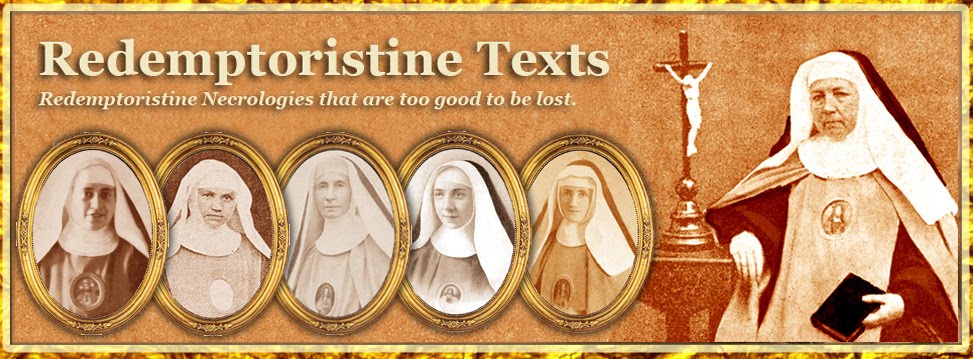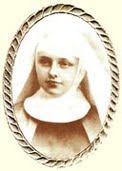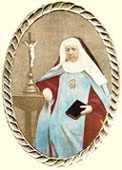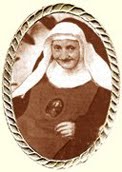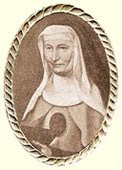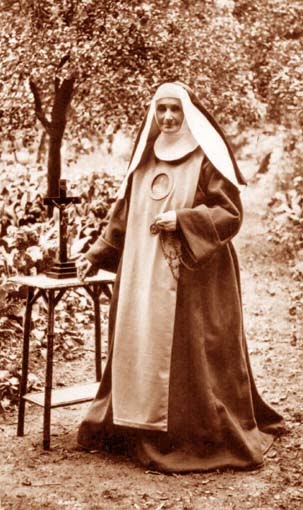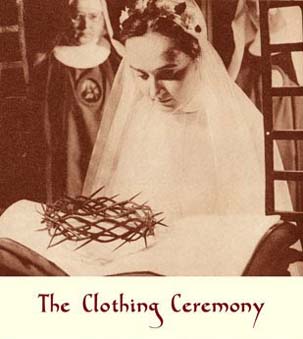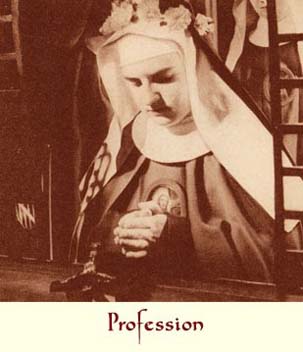How Sister Marie-Anne-Joseph pruned the vine and what resulted from it.
Elisabeth Kretzl was born at Bomilskrut, in Lower Austria, on 4th November 1828. Her parents were poor, but very pious. While she was still young she lost her father and a short time afterwards, her poor mother’s house was destroyed by fire, which was a great trial for the whole family. Elisabeth, the youngest of five children, then said to her mother: “Dear mother, I am going to Vienna to earn something, and I will send you what I can.”
After Elisabeth had served some time in Vienna, Jesus deigned to cast a glance upon her. One day when she was visiting the churches in this capital, she went with her companions into Saint Mary of the Riverbank, the church of the Redemptorist Fathers. The door to the sacristy was open. Elisabeth stopped there for a moment and looked at the priests who were reclothing the sacred ornaments. But at this very moment, the venerable Father Passerat, kneeling on a prayer-stool, with his head in his hands, was praying ardently. Through his fingers he noticed Elisabeth and cried out to her: “Eh, young lady, come here!” She did not understand him very well, and looked at the Father with great embarrassment. Her companions said to her in their peasant language: “He’s calling you. Go and talk to him.” She went up to him and the Father asked her: “Do you know how to prune vines?” When she replied in the affirmative, Father Passerat told her: “Go to the religious of Renweg and tell them that Father Passerat has said: “Take her, you can make something of her.” So she went there, without thinking that she was going to a convent. When she arrived in the Redemptoristines’ parlour, she repeated what Father Passerat had told her. At the words “you can make something of her” the Sisters started laughing. So they accepted the young lady on trial as a postulant door-keeper, and soon she rendered some very great services to the community.
These things happened in the year 1847. The following year, on 6th April, the Revolution broke out, and savage bands of revolutionaries broke into the convent. The religious had to flee in all haste to save their lives. It was in these days especially that Elisabeth showed her admirable devotion. Mr. Ignace Duxmer, one of the most devout servants of the community, was charged with remaining in the monastery, safeguarding what remained and preventing new misfortunes. On the first day he and Elisabeth could only weep and groan, because the scoundrels had smashed everything with their sabres, even the most beautiful pictures. Thanks be to God, on the next day, with the aid of some devout persons, they managed to save many objects, but this was not without courting great dangers.
However, the Sisters had founded the Convent of Ried, and Father Breslmeier was the community confessor. Mr. Duxmer told this venerable priest how faithful and devout Elisabeth had shown herself, and persuaded him that she would be an excellent door-keeper. So he called her, and as soon as she was able to leave service in Vienna, she came to the convent. This was in the month of October 1852. The smallpox epidemic that was raging then allowed her to make use of the knowledge she had acquired in a hospital in the service of the sick, and she took care of the sisters with the greatest devotion. In order to reward her, on 9th June 1853 she was received as a postulant converse. On 5th July 1855 she was given the religious habit, with the white veil and the name of Sister Anne of the Immaculate Conception. Elisabeth’s joy was immense.
* * * *
“You can make something of her.” Father Passerat’s words did not pass out of the good Sister’s memory, but she thought of them only in order to generously fulfil her duties as a converse Sister. Others thought of them too, but for another purpose. This Sister, who was so capable, so devout, and who had already rendered the Congregation some important services, also had a very beautiful voice. One very respected Sister, Sister Marie-Michelle, as she lay dying expressed the desire for Sister Anne to be elevated to the rank of Choir Sister. They agreed, and on 13th May 1857, the good Elisabeth made her profession.
Why was her name changed to Sister Marie-Anne-Joseph? It was no doubt because of her great devotion to the holy Patriarch. As soon as they began telling her about Saint Joseph, she became filled with enthusiasm, her eyes shining with happiness, and she never stopped in the praises she addressed to her great Patron. “I am convinced,” she said one day, “that Saint Joseph is in heaven in body and soul, because, on earth, he bore the Son of God in his arms, and He gave him the name of Father.” The books that spoke of Saint Joseph were her favourite books. Every day she honoured this great Saint and prepared herself for his feasts with a fervent novena, and in order to celebrate the 19th March properly, she disposed herself by the pious practice of the seven Wednesdays, so well explained by Saint Alphonsus. In brief, in all her difficulties, she would have recourse to Saint Joseph and advised others to do the same.
After her profession, says the convent chronicle, Sister Marie-Anne- Joseph felt herself at the peak of her happiness, as she had obtained what she had desired so much, and her heart overflowed with gratitude towards God and the monastery too. She successively fulfilled different tasks with great zeal. She sang and chanted psalms in choir with the greatest joy and showed herself no less ardent for meditation on holy things. It so happened one day that the venerable Father Breslmeier was struck down by a grave illness, and soon his life was in danger. When Sister Marie-Anne-Joseph learnt of it, she set herself to prayer with all the fervour of her soul: “My God,” she said, “preserve this holy priest for us, who has already done the convent so much good, and who is still working so much for Your glory. Are we then so rich in good priests? Oh, take me, my God, me, a poor useless religious, take me in place of this holy man.”
God accepted His servant’s offer. Father Breslmeier recovered and was able to go back to fulfilling all his functions, but Sister Marie-Anne-Joseph fell gravely ill. She said: “The good God has deigned to accept my sacrifice, and, in His infinite mercy, He has made me expiate my sins in this world.” The entire year that she had to spend in the infirmary was in fact like a year in Purgatory. In her last month especially, her sufferings became intolerable. She who had been so good and so devoted to the sick, now became incapable of making any movement. She became completely hydropic, having a horribly swollen and apparently gangrenous foot, and she was reduced, in her last days, to wringing her hands with pain, in the embrace of this terrible illness. In spite of everything, her patience did not abandon her. The prayers, especially the indulgenced prayers, to which she was accustomed to saying throughout her life, again found a place on her lips at the approach of death. As necessary, she asked her attendant to help her in this sweet business with God. Finally, on 6th August 1893, surrounded by all her Sisters in religion, fortified by the last sacraments and the exhortations of the holy Father Breslmeier, Sister Anne-Marie-Joseph rendered her soul to God with a smile.
The heavenly Vigneron had also pruned His vine.
After Elisabeth had served some time in Vienna, Jesus deigned to cast a glance upon her. One day when she was visiting the churches in this capital, she went with her companions into Saint Mary of the Riverbank, the church of the Redemptorist Fathers. The door to the sacristy was open. Elisabeth stopped there for a moment and looked at the priests who were reclothing the sacred ornaments. But at this very moment, the venerable Father Passerat, kneeling on a prayer-stool, with his head in his hands, was praying ardently. Through his fingers he noticed Elisabeth and cried out to her: “Eh, young lady, come here!” She did not understand him very well, and looked at the Father with great embarrassment. Her companions said to her in their peasant language: “He’s calling you. Go and talk to him.” She went up to him and the Father asked her: “Do you know how to prune vines?” When she replied in the affirmative, Father Passerat told her: “Go to the religious of Renweg and tell them that Father Passerat has said: “Take her, you can make something of her.” So she went there, without thinking that she was going to a convent. When she arrived in the Redemptoristines’ parlour, she repeated what Father Passerat had told her. At the words “you can make something of her” the Sisters started laughing. So they accepted the young lady on trial as a postulant door-keeper, and soon she rendered some very great services to the community.
These things happened in the year 1847. The following year, on 6th April, the Revolution broke out, and savage bands of revolutionaries broke into the convent. The religious had to flee in all haste to save their lives. It was in these days especially that Elisabeth showed her admirable devotion. Mr. Ignace Duxmer, one of the most devout servants of the community, was charged with remaining in the monastery, safeguarding what remained and preventing new misfortunes. On the first day he and Elisabeth could only weep and groan, because the scoundrels had smashed everything with their sabres, even the most beautiful pictures. Thanks be to God, on the next day, with the aid of some devout persons, they managed to save many objects, but this was not without courting great dangers.
However, the Sisters had founded the Convent of Ried, and Father Breslmeier was the community confessor. Mr. Duxmer told this venerable priest how faithful and devout Elisabeth had shown herself, and persuaded him that she would be an excellent door-keeper. So he called her, and as soon as she was able to leave service in Vienna, she came to the convent. This was in the month of October 1852. The smallpox epidemic that was raging then allowed her to make use of the knowledge she had acquired in a hospital in the service of the sick, and she took care of the sisters with the greatest devotion. In order to reward her, on 9th June 1853 she was received as a postulant converse. On 5th July 1855 she was given the religious habit, with the white veil and the name of Sister Anne of the Immaculate Conception. Elisabeth’s joy was immense.
* * * *
“You can make something of her.” Father Passerat’s words did not pass out of the good Sister’s memory, but she thought of them only in order to generously fulfil her duties as a converse Sister. Others thought of them too, but for another purpose. This Sister, who was so capable, so devout, and who had already rendered the Congregation some important services, also had a very beautiful voice. One very respected Sister, Sister Marie-Michelle, as she lay dying expressed the desire for Sister Anne to be elevated to the rank of Choir Sister. They agreed, and on 13th May 1857, the good Elisabeth made her profession.
Why was her name changed to Sister Marie-Anne-Joseph? It was no doubt because of her great devotion to the holy Patriarch. As soon as they began telling her about Saint Joseph, she became filled with enthusiasm, her eyes shining with happiness, and she never stopped in the praises she addressed to her great Patron. “I am convinced,” she said one day, “that Saint Joseph is in heaven in body and soul, because, on earth, he bore the Son of God in his arms, and He gave him the name of Father.” The books that spoke of Saint Joseph were her favourite books. Every day she honoured this great Saint and prepared herself for his feasts with a fervent novena, and in order to celebrate the 19th March properly, she disposed herself by the pious practice of the seven Wednesdays, so well explained by Saint Alphonsus. In brief, in all her difficulties, she would have recourse to Saint Joseph and advised others to do the same.
After her profession, says the convent chronicle, Sister Marie-Anne- Joseph felt herself at the peak of her happiness, as she had obtained what she had desired so much, and her heart overflowed with gratitude towards God and the monastery too. She successively fulfilled different tasks with great zeal. She sang and chanted psalms in choir with the greatest joy and showed herself no less ardent for meditation on holy things. It so happened one day that the venerable Father Breslmeier was struck down by a grave illness, and soon his life was in danger. When Sister Marie-Anne-Joseph learnt of it, she set herself to prayer with all the fervour of her soul: “My God,” she said, “preserve this holy priest for us, who has already done the convent so much good, and who is still working so much for Your glory. Are we then so rich in good priests? Oh, take me, my God, me, a poor useless religious, take me in place of this holy man.”
God accepted His servant’s offer. Father Breslmeier recovered and was able to go back to fulfilling all his functions, but Sister Marie-Anne-Joseph fell gravely ill. She said: “The good God has deigned to accept my sacrifice, and, in His infinite mercy, He has made me expiate my sins in this world.” The entire year that she had to spend in the infirmary was in fact like a year in Purgatory. In her last month especially, her sufferings became intolerable. She who had been so good and so devoted to the sick, now became incapable of making any movement. She became completely hydropic, having a horribly swollen and apparently gangrenous foot, and she was reduced, in her last days, to wringing her hands with pain, in the embrace of this terrible illness. In spite of everything, her patience did not abandon her. The prayers, especially the indulgenced prayers, to which she was accustomed to saying throughout her life, again found a place on her lips at the approach of death. As necessary, she asked her attendant to help her in this sweet business with God. Finally, on 6th August 1893, surrounded by all her Sisters in religion, fortified by the last sacraments and the exhortations of the holy Father Breslmeier, Sister Anne-Marie-Joseph rendered her soul to God with a smile.
The heavenly Vigneron had also pruned His vine.
This necrology is translated from Fleurs de l'Institut des Rédemptoristines by Mr John R. Bradbury. The copyright of this translation is the property of the Redemptoristine Nuns of Maitland, Australia. The integral version of the translated book will be posted here as the necrologies appear.
